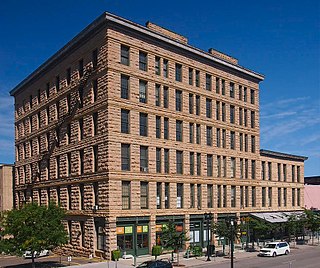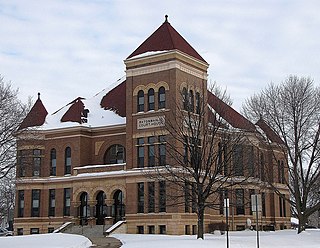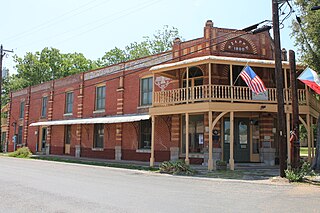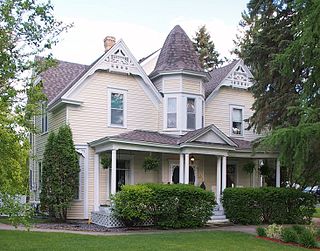
Godahl is an unincorporated community in Brown and Watonwan counties in the U.S. state of Minnesota.

The Traffic Zone Center for Visual Art (TZCVA) is an artist cooperative located in the historic Warehouse District of downtown Minneapolis, Minnesota, United States. Founded in 1993, TZCVA was established to create an artist-owned and managed building that provides stable, safe, and affordable studio, teaching and exhibition space for mid-career visual artists. TZCVA is a partnership between Artspace Projects, Inc., a leading national non-profit real estate developer for the arts, and a cooperative of 23 artist-members.

The Scales Mound Historic District is a historic district in the small Illinois village of Scales Mound. The district encompasses the entire corporate limit of the village and has more than 200 properties within its boundaries. The district was added to the U.S. National Register of Historic Places in 1990.
Franklin Historic Properties is a historical site operated by the Idaho State Historical Society in Franklin, Idaho. The site consists of the L. H. Hatch House, the Relic Hall, and Franklin Cooperative Mercantile Institution, which were separately listed on the National Register of Historic Places in 1973, 2001, and 1991 respectively.

This is a list of the National Register of Historic Places listings in Olmsted County, Minnesota. It is intended to be a complete list of the properties and districts on the National Register of Historic Places in Olmsted County, Minnesota, United States. The locations of National Register properties and districts for which the latitude and longitude coordinates are included below, may be seen in an online map.

The Boesch, Hummel, and Maltzahn Block, also referred to as the Boesch-Hummel-Maltzahn Block, is an historic building in New Ulm, Minnesota, United States. The private commercial structure was placed on the National Register of Historic Places (NRHP) on December 31, 1979. The building is significant for the extensive features of the front facade as compared to the other "Main Street" buildings in New Ulm and surrounding communities.

The Provo West Co-op is a mercantile institution and also the name of its historic building in Provo, Utah. The Early Commercial-style building was listed on the National Register of Historic Places in 1984 as "Provo West Co-op".

Causeyville, Mississippi is a small community in southeastern Lauderdale County, Mississippi, about twelve miles southeast of the city of Meridian. The Causeyville Historic District consists of four buildings at the center of the community — two general stores and two residences — that exemplify the pivotal contribution that small communities like Causeyville made to the development of Lauderdale County. The district was added to the National Register of Historic Places in 1986.

The Iron County MRA is a Multiple Resource Area addition to the National Register of Historic Places, which includes 72 separate structures and historic districts within Iron County, Michigan, United States of America. These properties were identified and placed on the Register in 1983, with the exception of one property that was placed on the Register in 1993.

The William W. Webster House is a historic house in Clearwater, Minnesota, United States, built around 1863. It was listed on the National Register of Historic Places in 1979 for having local significance in the themes of architecture and commerce. It was nominated for its Greek Revival architecture, fine craftsmanship, and association with William W. Webster, an early settler and civic leader in Clearwater.

The Watonwan County Courthouse in St. James, Minnesota, United States, is the seat of government for Watonwan County, in continual use since it was completed in 1896. It was listed on the National Register of Historic Places in 1987 for having state-level significance in the themes of architecture and politics/government. It was nominated for its exemplary Romanesque Revival architecture, its status as one of Minnesota's remaining monumental Victorian courthouses and as a local landmark, and its longstanding service as county seat.

The K. J. Taralseth Company was a prominent retail business in Warren, Minnesota, United States, in operation 1888–1959. The original building it occupied burned down in 1910, so the owners commissioned a new building the following year which is still standing. Both facilities contained the department store as well as space for other tenants—including a Masonic temple—and hosted numerous community events. The 1911 building in which the K. J. Taralseth Company was housed for almost half a century was listed on the National Register of Historic Places in 2002 for having local significance in the theme of commerce. It was nominated for representing a business and a venue that served a central role in the life of the community.

The Clarks Grove Cooperative Creamery is a historic creamery in Clarks Grove, Minnesota, United States. It was established in 1890 as one of the first cooperative creameries in Minnesota. The Clarks Grove Cooperative Creamery used new technology and a well-organized cooperative system. It became a model for the Minnesota dairy industry. Ten years later, there were more than 550 cooperative creameries in the state.

The Kahlert Mercantile Store is a historic commercial building in Browerville, Minnesota, United States. It was built in 1883 as Browerville was springing up around a newly built railroad line. The simple wooden building with a false front contained retail space on the ground floor and a community meeting hall upstairs. The building was listed on the National Register of Historic Places in 1985 for having local significance in the themes of commerce and exploration/settlement. It was nominated for being a highly intact example of the vernacular commercial architecture erected in Minnesota's railroad boomtowns.
The Brigham City Co-op was one of the most successful cooperative enterprises of the Mormons in Utah.

The Union Bond Store is a heritage-listed former warehouse, bond store and Westpac bank branch and museum located at 47 George Street in the inner city Sydney suburb of The Rocks in the City of Sydney local government area of New South Wales, Australia. It was designed by John Bibb and built from 1841 to 1842. It is also known as Union Bond Store (former) and Westpac Bank. The property is owned by Property NSW, an agency of the Government of New South Wales. It was added to the New South Wales State Heritage Register on 10 May 2002.

The Douglas General Mercantile, at 100 Main St. in Smithfield, Utah, was built in 1883 and was listed on the National Register of Historic Places in 1982.

The Zapp Building, later known as the Country Place Hotel and Restaurant, is a historic building in Fayetteville, Texas, United States. It was built in 1900 by builders Stidham and Kurtz in the Romanesque Revival style for local merchant Hugo Zapp to replace a wooden building at the site which burned down. Zapp bought a shop at this prominent location at the northwest corner of the town square in 1876. It was added to the National Register of Historic Places on June 23, 1983, and designated a contributing property to the Fayetteville Historic District by the registrar on July 10, 2008.

The H. G. Leathers House is a historic house in St. Francis, Minnesota, United States. It was originally built on a site near the Rum River around 1883. Around 1890 it was moved closer to the river and expanded. The property was listed on the National Register of Historic Places in 1979 for its local significance in the themes of architecture and commerce. It was nominated for its association with three generations of an influential local family, and for its status as one of Anoka County's few Victorian houses.

The John H. Norton and Company Store is an historic structure in Willcox, Arizona. Built circa 1880, it was added to the National Register of Historic Places in 1983.






















